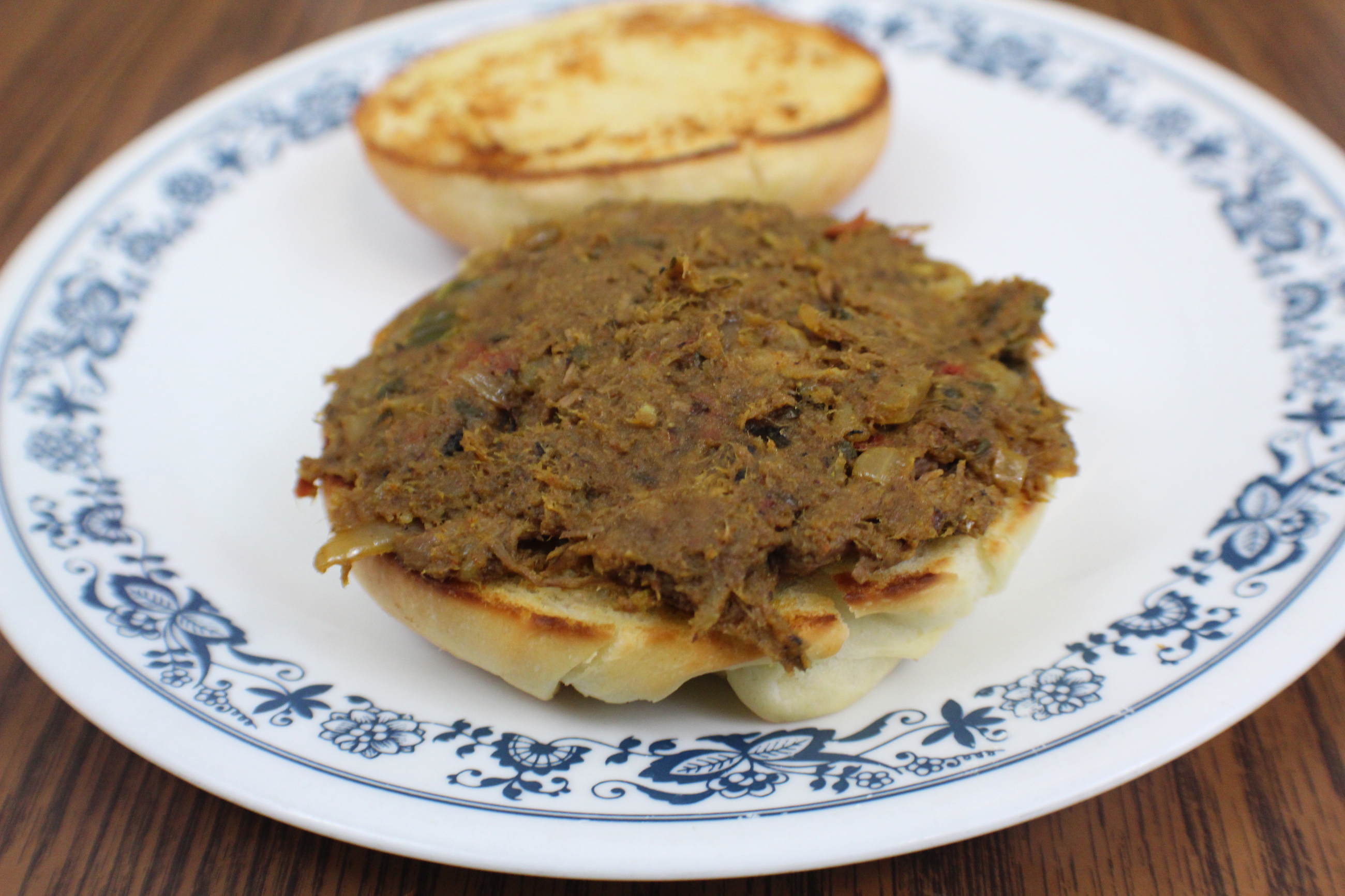Řízek v Chlebu, a Czech Schnitzel Sandwich
Bear with me for a moment. This one wanders.
Some (mostly) Relevant History
In the 4th Century, the Roman Governor of Aemilia-Liguria, Ambrose, was unexpectedly named Bishop of Milan. His brother Satyrus, who also held public office, resigned his post to take over management of his brother’s secular affairs. This management required regular voyages by ship to Africa and back. After Satyrus’ death in 378, Ambrose eulogized him passionately, making the miraculous claim that on one of those voyages, when his ship had been dashed against some rocks and was breaking up, Satyrus requested a communion host from one of his fellow passengers, wrapped it in a handkerchief and hung it around his neck, then threw himself into the water, trusting in God (and also “owing to strong swimming” according to the same eulogy) to save him. This fantastic story contributed to the eventual canonization of Satyrus (along with Ambrose and their sister Marcellina). His birthday of September 17th became the feast day of Saint Satyrus.
We thought that he who was returned from Africa, restored from the sea, preserved after shipwreck, could not now be snatched
from us; but, though on land, we suffered a more grievous shipwreck, for the death of him whom shipwreck at sea owing to strong swimming could not kill is shipwreck to us…What, then, shall I say of his reverence in regard to the worship of God? He, before being initiated in the more perfect mysteries, being in danger of shipwreck when the ship that bore him, dashed upon rocky shallows, was being broken up by the waves tossing it hither and thither, fearing not death but lest he should depart this life without the Mystery, asked of those whom he knew to be initiated the divine Sacrament of the faithful; not that he might gaze on secret things with curious eyes, but to obtain aid for his faith. For he caused it to be bound in a napkin, and the napkin round his neck, and so cast himself into the sea, not seeking a plank loosened from the framework of the ship, by floating on which he might be rescued, for he sought the means of faith alone. And so believing that he was sufficiently protected and defended by this, he sought no other aid…
Centuries later, in 1148, an archiepiscopal decree described the meal that was permitted for the feast of St. Satyrus every September 17th. Nine dishes over three courses are described, notably including something called lumbolos cum panicio, or loin with breadcrumbs. This is the earliest known description of the breaded meat dish that would become cotoletta alla Milanesa. From cotoletta alla Milanesa comes the Milanesa of South and Central America and Mexico; from “cutlet” comes the tonkatsu of Japan, and various other breaded cutlet dishes around the world; and a popular myth would have you believe that Milanesa also led to the signature dish of Austria, Wiener Schnitzel.
According to an apocryphal story popularized by Felice Cunsolo in 1969’s Guida Gastronomica d’Italia, while Joseph Radetzky von Radetz was the Governor-General of Lombardy-Venetia for the Empire of Austria, Emperor Franz Joseph I took notice of a margin note from an adjutant’s report that mentioned a tasty breaded steak he’d sampled while in Italy. Upon Radetzky’s return to Vienna, Emperor Joseph demanded that the recipe for this dish be provided to his chefs, and thus Wiener Schnitzel was born.
Of course it’s not true. Nobody in Austria had heard of this story before it was published in Cunsolo’s book; the specific adjutant mentioned does not appear to have existed; no evidence of the marginalia cited has ever been turned up; and most importantly, Radetzky did not take over as Governor of Lombardy until 1848, while a recipe for Wiener Schnitzel appeared in print as early as 1831–or at least, a recipe for breaded, fried veal, called “Gebackene Schnitzel von Kalbsbraten” rather than Wiener Schnitzel. Instead, Austrian cooks were coating meat in breadcrumbs and frying it as early as the 16th Century. When the popular but extravagant practice of “gilding food” was banned in 1514, Austrian chefs borrowed the breading and frying technique from Byzantine Jews to simulate that rich and golden coating they were missing.
Schnitzel? Řízek
So there may be no actual direct link from the Feast of Saint Satyrus to Wiener Schnitzel after all. But there is a direct link from the Austrian schnitzel to the Czech řízek, a Schnitzel in all but name. Veal can be used to make a řízek, as with the Wiener Schnitzel; so can chicken. But the most popular meat choice for a Czech schnitzel is pork. Řízek may not be the national dish of the Czech Republic–that distinction likely goes to Svíčková, roast beef tenderloin served with gravy–but řízek is very popular among Czech nationals. So popular in fact that one page I read joked that you can tell the who the Czechs are on a hike because they’ll have a schnitzel or two in their backpack. Stereotypes like that are boring, lazy, and unfunny; yet Czechs online seem to bear this out, posting about taking schnitzels on a hike, or a trip, or on the schoolbus. Řízek is frequently served with something starchy–French fries or potato salad or other potato dishes, or rice, or–especially on the go–between two slices of bread (chlebu in Czech) as a sandwich.
And that brings us back to… well, us.
A true connoisseur of Wiener Schnitzel will talk about the required puffy crust, when the breading separates from the meat, leaving a layer of air between bread and meat. This allows the breading to become remarkably light and crisp. This is achieved by using the standard 3-step breading method–the flour keeps the breading from adhering directly to the meat, and steam generated during cooking inflates the breading like a balloon. I did use a 3-stage breading station but I don’t know that I consistently achieved this result. I’m not sure if such a perfect schnitzel would survive being slapped between bread, wrapped in paper, and tossed in a pocket or a backpack for a few hectic hours. But my řízky–that is the plural form of řízek–turned out nicely crisp. I ran out of one brand of breadcrumbs halfway through and switched to another, resulting in the two-tone photo above. And some of the pork cooked a bit longer than others, resulting in the range of colors depicted below.




Czech bread tends toward a wheat/rye blend, spontaneously fermented and hand-formed–rye sourdough, essentially, and their sandwiches are frequently condimented with some combination of mayonnaise, Dijon-style brown mustard, and garlicky dill pickles similar to Polish dills.






Řízek v chlebu means, simply, schnitzels and bread. It is not a complicated sandwich to make.





But for purposes of verisimilitude, I wrapped them in butcher paper and let them sit at room temperature for a few hours. I refrained, however, from putting them into a backpack and slinging that around a hiking trail, or tossing it onto the cargo rack of a commuter train.

And when I cut those sandwiches open a few hours later, I could see that I did manage to get a little of that puffy crust on at least a couple of them.

Simple sandwiches rely on the quality of their ingredients, and while these may not have stood the scrutiny of a Czech babička, they did satisfy my palate. A breaded, fried pork cutlet, simply seasoned, is a universal delight, from the tenderloins of Iowa, Illinois, and Indiana to the tonkatsu of Japan. These were no exception. Dressed with black pepper and lemon juice, with pickles and mayonnaise and good brown mustard, the simple salt seasoning of the breading was no detriment to their flavor. Řízek is made from the pork “collar,” which corresponds roughly to the butt, a fattier, tastier, chewier piece of meat than a tenderloin or pork chop, and despite being pounded flat these were less than perfectly tender–but in a good way. Al dente, I suppose you might say, to bring us back to Italy, though perhaps not quite fully returning us to our shipwrecked 4th Century Saint Satyrus where we began.

But it’s as good a point to leave off as any. February is only hours away, with three new sandwiches for us to enjoy. I hope you’ll come back and check those out with us! And as always, if there are any devotees of the Řízek v chlebu out there who feel we’ve given it short shrift, please make yourself known in the comments! We want to know how we can do better!

I like sandwiches.
I like a lot of other things too but sandwiches are pretty great
















Recent Comments